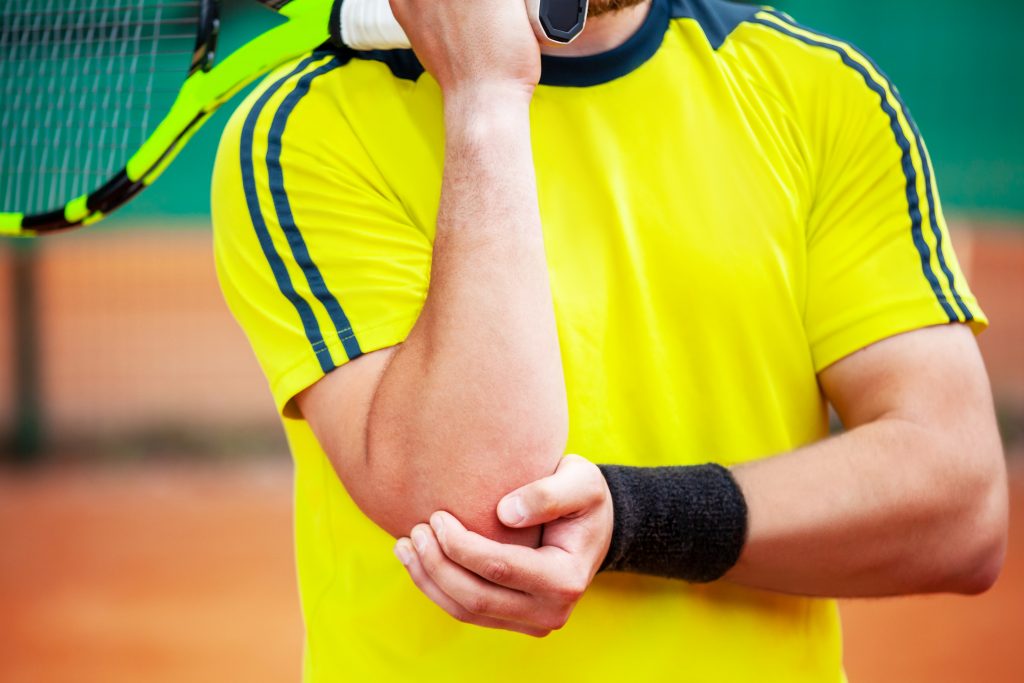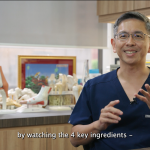
As the rainy weather rolls around again, tennis players across our region will be asking themselves the old familiar questions: Will my session be cancelled? How much time do I have to waste drying the court? Why don’t the rollers ever work?
Apart from the risk of lightning strikes, falls and accidental drownings, the wet conditions can contribute to tennis injuries in unexpected ways. When you play with wet balls, the increased weight of the balls will put more stress on every joint, tendon and muscle; every single stroke.
In this series, we will take a look at various common injuries that may plague tennis players.
Tennis Elbow
No other injury is as synonymous with the game itself. However, most of the patients I’ve treated don’t even play the game. Obviously, there are many everyday causes which contribute. It’s just not quite as sexy or sporty if you call it Grocery Elbow or Elbow Shopping-itis, but the mechanism is the same. This can happen with carrying heavy bags or over-gripping your racquet. The injury is caused by overuse of the Wrist and Finger Extensors. These guys originate from the Lateral epicondyle, the most prominent outer bony point of your elbow. Hence the pain is usually centred here, although it may spread down into the forearm as well.
Tennis Elbow is not due to tendonitis, an inflammatory condition. Microscopic studies show it as a degenerative disorder due to chronic overuse and aggravated by aging, it is a tendinosis instead.
In tendinosis, the collagen fibres are immature and do not align or link themselves normally. This makes the structure weak, resulting in pain and loss of strength. This means that the injury is more of a chronic buildup over time rather than one single event/accident. This injury doesn’t mean you’re old, it’s just that the mileage tends to increase with age. We tend to see it in patients above 30.
How does Tennis Elbow occur?
In Tennis, it most often happens on the Backhand side, especially for Single-handed players. This is expected as you have only one elbow doing all the work. Switching to a Double-handed will help (just doesn’t look as cool).
An off-centre hit will also generate more vibrations which travel down the racquet frame and up your arm. These vibrations cause pain in the damaged fibres, resulting in a feeling of weakness. Making good contact off the sweet-spot on your stringbed will lessen the vibrations greatly.
String choice affects the amount of vibration generated with each stroke. Most Pros use polyester strings. This gives them more spin for better control despite bigger hitting. Unfortunately, Polys are very hard on the elbow and will increase your risk of Tennis Elbow. Natural gut is most forgiving but expensive and harder to maintain. A solution could be a hybrid stringing setup with Poly/multi-filaments to decrease the vibrations. All Poly setups should also be strung at a lower tension than for multi-filaments.
Over-gripping the handle makes this worse as the muscles are tensed even more than necessary. A larger grip size will help avoid this.
Being late on your swing will result in wrist flexion at the point of contact and a tendency to flick your wrist. These will put your Extensor muscles at a mechanical disadvantage, requiring more force to maintain the same grip. Keeping your wrist neutral or slightly extended at the point of contact will reduce this stress.
Wet courts will make late contact with the ball more likely due to decreased mobility.
Wet balls will put an increased stress on the elbow regardless of technique.
So a simple piece of advice, DON’T play with wet balls.
How you can reduce your risk of Tennis Elbow
Warming up your elbow with some stretches and simple exercises is a good way to avoid injury. Starting with some half-court tennis helps to warm up all the joints and muscles you need. Stretching during breaks and after the game will also reduce the risk of injury.
Treating Tennis Elbow
If the pain persists, it’s better to get it looked at. Tennis Elbows are a lot easier to treat when they have not been festering for months. Sometimes all that’s needed is some targeted stretching and activity modification.
For more severe/ persistent cases, a Platelet-rich Plasma (PRP) injection may be appropriate. This can be done in the clinic and involves taking 7-10mls of blood and placing it in a centrifuge. The larger Red and White blood cells are removed, leaving behind the Platelets with their growth factors. This is then injected into the damaged tissue to jump-start the healing process. The entire process takes about 10-15 minutes. Studies on PRP for Tennis Elbow have consistently shown good results.
Treatment of Tennis Elbow must include an assessment of technique and recognition of the factors contributing to the overuse. There must also be a focussed strengthening program to acclimate the elbw to the workload anticipated. Failure to treat it holistically will likely result in recurrence.
With more players switching to a more Western grip on the Forehand side, we are seeing a “New Tennis Elbow”. This is pain on the inner side of the elbow and is due to tendinosis of the Flexor tendons. Heavy brushing up on the ball with an extreme Western grip has increased the workload on the Flexors, resulting in an injury better known as Golfer’s Elbow.
In the next instalment, we will look at the Shoulder and Wrist joints for common Tennis-related injuries.

Dr Derrick Oh
Consultant Orthopaedic Surgeon
Island Orthopaedics
Our Specialist
Dr. Derrick Oh is trained in two sub-specialties, sports and trauma surgery and possess dual accreditation in Sports Medicine and Orthopaedic Surgery. He also specialises in cartilage regeneration, knee and shoulder replacement surgery.









